In the days before canning and refrigeration, people had to rely on other methods of food preservation, such as immersion in fat or oil, pickling in alcohol or vinegar, salting (raw salt or brine) and smoking. When the Spanish and Portuguese built distant empires in the fifteenth and sixteenth centuries they used all of the above and created a particular new flavour in meat and fish by adding pimentón (paprika) to vinegar and garlic. Preserving food in vinegar was not new – the ancient Chinese, Persians and Greeks were well aware of vinegar’s antibacterial and medicinal nature. Therefore, the Iberians were likely to have come into contact with vinegar preserving techniques by the time of their Roman occupation and if not, it was definitely a common method of food conservation under the Moorish Caliphate.
The Spanish Conquistadors brought pimentón back to Europe from Mexico, as a gift for the King and Queen – they duly passed it on to monks who started to grow it. Native Americans used this red pepper as a flavouring and medicine. Paprika became a very popular seasoning in both Spain and Portugal, where it’s synonymous with cured meat products such as chorizo. Pimentón, like vinegar, is a natural preservative (and is used to this day in curing ham), so combining the two for food preservation makes a lot of sense, though I’m not sure that the Iberians were aware of this at the time and may have just enjoyed the taste. The Spanish called this mixture Adobo, the Portuguese equivalent being Vinha d’alhos (which is the origin of vindaloo).
These days, adobo is more commonly used as a marinade (prior to cooking), although food cooked in vinegar and pimentón (en escabeche) for preservation in cans or jars is still incredibly popular. In Mexico and South America, adobo has taken on a new dimension as a sauce marinade or sometimes dry rub. Philippine adobo is somewhat different. When the Spanish conquered the Philippines in the late sixteenth century, they discovered that the indigenous people had a cooking method that used vinegars (cane, coconu, palm, etc.) soy, garlic and other ingredients, but not generally pimentón. The Spanish called this adobo de los naturales (adobo of the natives) and the term adobo has stuck. The word adobo comes from the Spanish verb adobar – to marinate.
Adobo recipe:
6 cloves garlic (finely chopped)
3 sprigs thyme (torn up)
1 heaped teaspoon dried oregano
6 juniper berries (crushed)
10 black peppercorns
2 bay leaves
a heaped teaspoon pimentón de la Vera dulce
a heaped teaspoon pimentón de la Vera picante
1/2 cup red wine vinegar
1/2 cup extra virgin olive oil
This is a Spanish style adobo, using pheasant, though it would be good with any kind of fresh meat. This one weighed about 3 lb and therefore had the potential to be a bit tough. Note the yellow fat under the skin. This pheasant has been feasting on corn.
Mix up the above adobo recipe and joint the meat. I took the breasts off the bone, but left the legs and wings intact. I included juniper berries specifically because this is a game dish, but I’m sure they’ll go very well with pork.
Immerse the pheasant in the adobo.
Cover the dish and refrigerate for 2 days, by which time the pheasant becomes adobado (marinated/pickled). You should see a change in colour, the meat goes from red to brown (above). Remove the bird from the marinade and wipe it dry. Do give the meat and marinade time to come to room temperature (an hour or so) before cooking.
Pheasant in Adobo recipe (serves 2 -3 people):
1 pheasant jointed
3 slices smoked streaky bacon (chopped)
1 large onion (chopped)
6 cloves garlic (finely chopped)
1 stick celery (chopped)
1 red pepper (chopped)
15 Kalamata olives
2 dessertspoons olive juice
1 dessertspoon tomate purée
2 large squirts anchovy paste (to taste)
1/4 pint pheasant stock
adobo marinade
In some fresh olive oil, fry 3 slices of chopped streaky bacon. Remove to a plate when done.
Using the bacon fried oil, brown the pheasant pieces all over and reserve.
Gently caramelise the chopped onion in the same oil.
When the onion is golden brown, stir in the celery, sweet red pepper and garlic to form a holy trinity.
Return the pheasant and bacon to the casserole, along with the Kalamata olives, bay leaves, tomato purée and anchovy paste.
Scoop off any oil floating at the top of the marinade (I used this to roast some potatoes – it could be used to brown the pheasant, but I thought that it would be inclined to spit) and stir the adobo into the casserole, along with the stock. The olives came in olive oil and brine, which tasted quite good, so I added a splash or two of that to taste. Simmer on the hob uncovered for an hour.
Serve with rice or boiled potatoes and a glass of Anciano Gran Reserva tempranillo.
The flavour of the dish was quite surprising – there was no taste of vinegar whatsoever, the pimentón had mellowed considerably and the olives, onions and red peppers really stood out. The pheasant was exceptionally tender. This adobo would be perfect for venison or hare and work wonders on a tough cut of beef or pork.

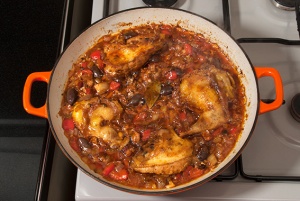
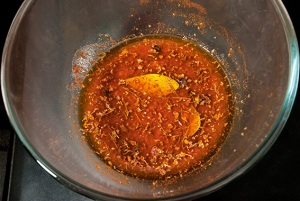
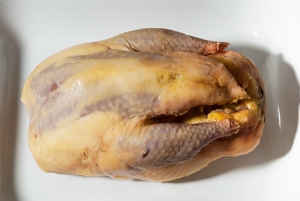

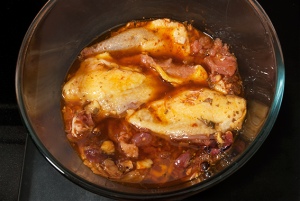
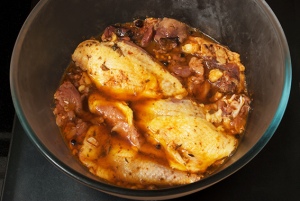

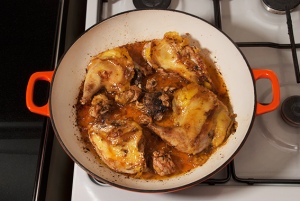
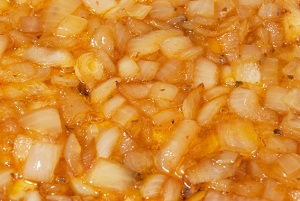
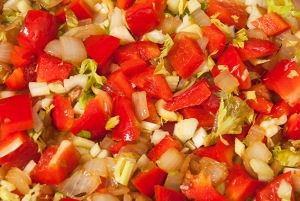
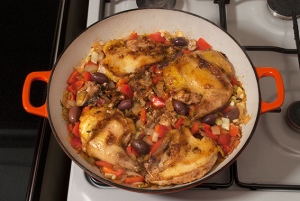
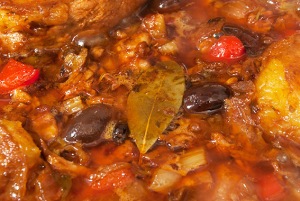

Saying hello from right within the ring of fire around Sydney. Scared stiff ! Still at home and on one of the last two quieter days we might have without being ’emergency’ again . . . I have actually very much enjoyed your lesson on adobo cooking ! Oh I have made many adobo dishes but of the Philippine origin and had little idea of the background and original meaning of the term. Absolutely love your adobo recipe . . . definitely better than mine – thanks ! And should I be able to be in my own home come Yule I may just have found what to cook with it ! Pork methinks 🙂 !!
Thanks Eha – I meant to say above, that the marinade is very good for barbecue, which would be perfect in Sydney during a normal summer.
I hope you get some heavy rain soon!
Glad to see the game lady is keeping you in pheasant. That sounds wonderful.
Thanks Michelle – she’s an absolute star!
The entire post is so interesting and the recipe looks incredible! This has made the list of culinary must tries.
Thanks Tammy – I’m so glad you like it!
I so love your posts with the history behind the dish you are creating. This is a recipe that I might be able to prepare. We have a friend who is out in Wyoming hunting. If he comes back with pheasant, perhaps I can talk him out of one.
Thanks Karen – I hope you get lucky, but if not, chicken or guinea fowl should suffice.
A very interesting post as I never thought of pimentón as a preservative. Another great game recipe and one that I’ll be saving for the next fasan that finds it’s way into my kitchen. I love the juniper addition.
Thanks Ron – it’s very common, even in America, to rub a dry cured ham with pimentón to inhibit bugs, especially around the bone and ends.
Pingback: Pollo en Adobo | Mad Dog TV Dinners
Pingback: Lomo de Orza | Mad Dog TV Dinners